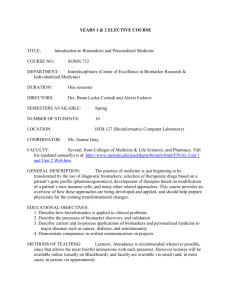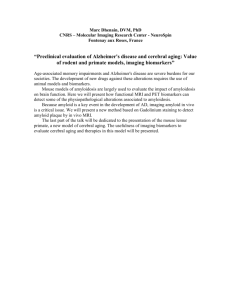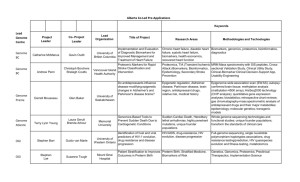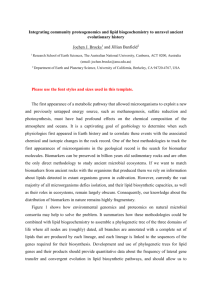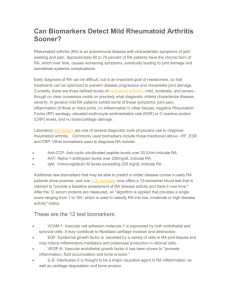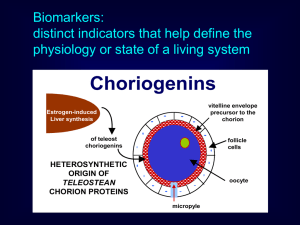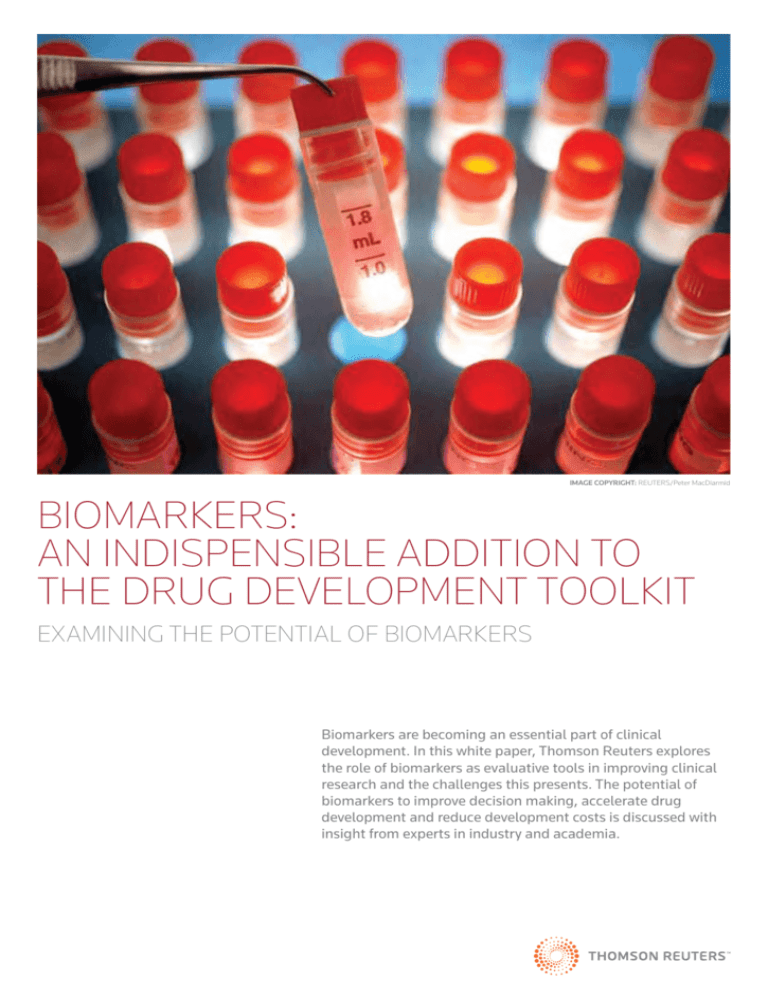
Image Copyright: REUTERS/Peter MacDiarmid
Biomarkers:
An indispensible addition to
the drug development toolkit
EXAMINING THE POTENTIAL OF BIOMARKERS
Biomarkers are becoming an essential part of clinical
development. In this white paper, Thomson Reuters explores
the role of biomarkers as evaluative tools in improving clinical
research and the challenges this presents. The potential of
biomarkers to improve decision making, accelerate drug
development and reduce development costs is discussed with
insight from experts in industry and academia.
To find out more information on the Biomarkers Module go to
go.thomsonreuters.com/biomarkers or email
scientific.lifesciences@thomsonreuters.com
BIOMARKERS: AN INDISPENSABLE ADDITION TO THE DRUG DEVELOPMENT TOOLKIT
Biomarkers are fast becoming an essential part of clinical
development, not least because they offer a faster alternative to
the conventional drug development approach and the promise
of ‘safer drugs, in greater numbers, approved more quickly’1.
In recent times, the conventional approach has been courting
failure more than it has success. The attrition rate for drugs in
clinical development is high: the percentage of tested products
entering phase I trials that eventually gain regulatory approval
has been estimated at a paltry 8%2.
Many of these failures happen late in clinical trials, with the
consequence that expenditure in clinical drug development —
already a mammoth effort requiring a huge amount of money,
time, and patients — is increasing. One study calculated that
the cost of developing a drug increased by over 50% between
2002 and 20073.
Another consequence is that very few drugs are making it out
of the clinical research pipeline. In 2007, the FDA approved
just 17 new molecular entities and 2 biologic licenses, the
lowest number since 19834. Faced with these figures, there
are growing concerns across the industry that pharmaceutical
research is not bringing in sufficient gains for shareholders or
for society5.
This is mainly due to a gap in the industry’s ability to predict a
drug candidate’s performance early, and with a large degree of
certainty. According to David Roblin, Vice President and Head
of Clinical Development for Respiratory at Pfizer, predicting
clinical efficacy is one of the “greatest bottlenecks in drug
research and development”6.
The convention in clinical research has been to measure the
performance of novel therapies using clinical outcomes. This
approach is laborious, inexact and, as the US Food and Drug
Administration (FDA ) puts it, decades old. Many would agree
when they say that novel therapies are not progressing through
development and getting to patients as quickly as they could be7.
Biomarkers as an essential
part of clinical development
Biomarkers — a measure of a normal biological process in the
body, a pathological process, or the response of the body to a
therapy — may offer information about the mechanism of action
of the drug, its efficacy, its safety and its metabolic profile.
There is wide consensus that biomarkers are and will be useful
as evaluative tools in improving clinical research. Biomarkers
feature heavily in the FDA ’s Critical Path Opportunities List
for their potential to speed the development and approval of
medical products8.
Because biomarkers can predict drug efficacy more quickly
than conventional clinical endpoints, they hold the potential to
substantially accelerate product development in certain disease
EXAMINING THE POTENTIAL OF BIOMARKERS
areas9. And because they help identify earlier those candidates
that are likely to fail, they reduce drug development costs,
giving life to the concept of ‘fail early, fail cheap’.
The FDA estimates that just a 10% improvement in the ability
to predict drug failures before clinical trials could save US$100
million in development costs per drug10. Biomarkers also
offer the potential to inform treatment decisions and to bring
personalized medicine into clinical practice.
“Biomarkers have certainly impacted
on our internal decision making on
whether to move forward to the next
phase of clinical development”
James Weatherall, AstraZeneca
“Biomarkers have certainly impacted our internal decision
making on whether to move forward to the next phase of clinical
development,” says James Weatherall, Research Clinical
Scientist in Informatics at AstraZeneca. “We wouldn’t make a
decision to move to the next phase on biomarker evidence alone,
but they can offer strong supporting evidence and in the future
will be the key data in certain programs. They offer an objective,
biological indicator, rather than just seeing whether the patients
feel better.”
A brief history of biomarkers
The idea of using biomarkers to detect disease and improve
treatment goes back to the very beginnings of medical
treatment. The practice of uroscopy — examining a patient’s
urine for signs of disease — dates back to the 14th century or
earlier, when practitioners would regularly inspect the color and
sediment of their patient’s urine and make a diagnosis based
on what they observed11.
Today, your doctor may use spirometry to measure your
lung function, take your blood pressure as a measure of your
cardiovascular health, or test your blood glucose for diabetes.
And not only are biomarkers useful at the ‘bedside’; biomarkers
have already proved their worth at the ‘bench’ as well.
Philadelphia chromosome: In 1960, researchers discovered
that some patients with chronic myelogenous leukemia (CML),
a form of adult leukemia in which there is a proliferation of
myeloid cells in the bone marrow, have a specific genetic
change associated with their cancer, a shortened version of
chromosome 22. This abnormality, known as the Philadelphia
chromosome, is caused by a translocation between
chromosomes 9 and 22. The consequence of this genetic swap
is the creation of the BCR-ABL ‘oncogene’; this cancer-causing
gene produces a protein with elevated tyrosine kinase activity
that induces the onset of leukemia12. Researchers were able to
use the Philadelphia chromosome as a biomarker to indicate
which patients would benefit from drug candidates (tyrosinekinase inhibitors) specifically targeting the rogue protein. The
end product was the drug imatinib (Gleevec), which decreases
the proliferation of Philadelphia chromosome+ cells and slows
the progression of the disease. As a postscript to this story,
BIOMARKERS: AN INDISPENSABLE ADDITION TO THE DRUG DEVELOPMENT TOOLKIT
researchers further found that specific mutations in the
BCR–ABL gene were biomarkers that predicted resistance to
imatinib, leading to the development of newer tyrosine-kinase
inhibitors dasatinib and nilotinib.
HIV viral load: In the late 1980’s, scientists discovered that HIV
viral load could be used as a marker of disease progression, and
subsequently, as a measure of antiretroviral treatment efficacy.
Viral load was used to show that patients receiving combination
therapy had a higher reduction in viral load than those on
monotherapy, and was therefore more effective in slowing the
progression of the disease. Eventually, the viral load biomarker
was used in the development and assessment of Highly Active
Antiretroviral Therapy (HAART) treatment regimens involving a
combination of several drugs used by many people living with
HIV today.
HER-2 gene and receptor: Probably the most famous biomarker
in recent drug development history is the HER-2 gene and
receptor, discovered in the mid 1980’s. Between 20–30% of
breast cancer patients show an over-expression of the HER-2
receptor on their cancer cells. Although this biomarker indicates
a higher risk of adverse outcomes, it also gave clinicians a
new target for novel therapies. The antibody trastuzumab
(Herceptin) was developed to target HER-2 receptors in
these ‘overexpressing’ patients, and successfully reduces the
proliferation of cancer cells in many of these women.
Preventing drug development disasters
The need for biomarkers to guide clinical research is perhaps
best highlighted in the stories of recent drug development
failures. Between 1995 and 2005, at least 34 drugs were
withdrawn from the market, mainly as a result of hepatotoxic or
cardiotoxic effects13. Many of us are familiar with the withdrawal
in 2004 of the anti-inflammatory drug rofecoxib (Vioxx) due to
concerns about its increased risk of heart attack and stroke, and
more recently with the extremely serious adverse effects in the
phase I clinical trial and subsequent failure of the monoclonal
antibody, TGN1412.
TGN1412: This monoclonal antibody, produced by the firm
TeGenero, was known as a ‘superagonist’, designed to directly
stimulate an immune response. The therapeutic was originally
intended to treat B cell chronic lymphocytic leukemia and
rheumatoid arthritis, and had been tested pre-clinically with no
toxic or pro-inflammatory effects14.
In 2006, six healthy male volunteers took part in a phase
I clinical trial to test the safety of the candidate. Within 90
minutes of receiving the drug, all six men were experiencing
the beginnings of a ‘cytokine storm’, a term that describes a
cascade of proinflammatory cytokine release and the harmful
EXAMINING THE POTENTIAL OF BIOMARKERS
responses that they evoke, including fever, pain, and organ
failure due to hypotension. Although all the men survived, they
required weeks of hospitalization.
The cost of failures such as TGN1412 in terms of patient
health and lost resources is huge. For many, the TGN1412 trial
represented a failure in preclinical safety testing. It has been
suggested that had procedures using safety biomarkers to
guide dosing and predict the toxicity of this drug been used,
the disaster may not have occurred15. As an indication of the
subsequent recognition of the importance of biomarkers, in
vitro procedures using safety biomarkers are now being applied
to novel drugs that, like TGN1412, have the potential to act on
the immune system.
Biomarkers today
“Clinical trials are designed
upon biomarker assays”
Jeffrey Ross, Albany Medical Center
Today you “would not even conceive” of developing a new drug
without simultaneously looking for biomarkers for efficacy,
safety, and to measure the pharmacodynamics of the drug,
says Dr Jeffrey Ross, Head of Pathology at the Albany Medical
Center in New York and one of the researchers involved in the
original work on HER-2.
The field of oncology is leading the way in the use of
biomarkers in drug development. “Clinical trials are designed
upon biomarker assays,” says Ross. “If you look today, so
many abstracts of phase II and III cancer trials talk about
what biomarkers were selected. In vivo biomarkers, imaging
biomarkers, blood and tissue based biomarkers, on and on and
on. They are in every one.”
One example of a biomarker in use in oncology is circulating
tumor cells (CTCs), a biomarker present in the blood of cancer
patients. At the moment, CTCs are used in the development
of anti-cancer drugs as an objective and direct measurement
of the response of the cancer to a novel agent. “It can give a
pharmaceutical company a very early signal of efficacy,” says Ross.
“If you’re not knocking down the circulating tumor cells early
in the trials, you may say, let’s save our money for the next
agent.” Although still in development, this biomarker holds
further promise: the number of CTCs in the blood of patients
with breast cancer, for example, is potentially a prognostic
biomarker, and there is currently research ongoing to find out
whether a decrease in CTCs associated with treatment can be
used as a predictive biomarker of long-term benefit.
This use of biomarkers as alternatives to clinical endpoints in
drug development, alongside an increased understanding of
disease and the availability of funds for research into cancer,
has meant that oncology has not experienced the downturn
in drug development experienced by many other therapeutic
areas. “In fact, there has been acceleration in the development
and introduction of new agents in the past ten years,” says Ross.
BIOMARKERS: AN INDISPENSABLE ADDITION TO THE DRUG DEVELOPMENT TOOLKIT
Personalized medicine in oncology
In particular, oncology has led the way in the use of genetic
and proteomic biomarkers in drug development to predict an
individual’s response to treatment, starting with trastuzumab
(Herceptin) in 1998 and imatinib (Glivec) in 2001.
“Candidate genes that determine responsiveness to a drug are
important in biomarker studies,” says David Roblin of Pfizer. “The
old way that we used to do clinical trials was to enroll all patients
with a given disease independent of gene or phenotypic makers.
But if we can select a population with the particular gene which we
believe to be important for response to a novel therapeutic, then we
can run a smaller clinical trial to see whether it works or not.”
James Weatherall of AstraZeneca agrees. “What the regulatory
bodies are asking for increasingly these days is not a one-sizefits-all medication, but one in which you can say what particular
characteristics the patient would have to have for this medication
to be most beneficial. If we can start to do that using genetic
or protein markers in a rigorous way, then that’s an incredibly
powerful way to target the medication.”
The chemotherapy drug irinotecan (Camptosar) is one example
of personalized medicine, using a biomarker to guide both
clinical practice and subsequent clinical trials. Irinotecan is
used to treat advanced colorectal cancer. Once administered,
irinotecan is activated to the metabolite SN-38, and then
eventually inactivated in the body by the UGT1A1 enzyme.
In 2005, the US Food and Drug Administration added a warning
to the label of the drug, stating that patients homozygous for a
particular a version of the UGT1A1 gene — the UGT1A1*28 allele,
associated with decreased UGT1A1 enzyme activity — should be
given a reduced dose. Because patients with this allele clear the
drug less quickly from their body than the rest of the population,
they effectively receive a greater exposure to the drug from
the same dose. As a consequence, they are at higher risk of
potentially life-threatening side effects such as neutropenia (a
decrease in white blood cells) and diarrhea16.
The toxicity of irinotecan has long been a concern, and this
biomarker now allows clinicians to better identify those patients
who are at high risk of serious side-effects (about 10% of the
population are homozygous for UGT1A1*28).
And while this pharmacogenomics information has helped
improve the clinical use and efficacy of irinotecan, it has
also fed back into the development of other drugs; almost
immediately, this new understanding prompted the use of
the UGT1A1 biomarker to guide other studies ongoing at the
time, including several new irinotecan and oxaliplatin-based
chemotherapy regimens17.
EXAMINING THE POTENTIAL OF BIOMARKERS
Using preclinical biomarkers
as evidence of efficacy
As mentioned above, biomarkers can accelerate research by
substituting for clinical symptoms as a measure of efficacy. A
clear example of this in preclinical research can be seen in the
use of biomarkers for developing drugs for benign prostatic
hyperplasia (BPH). Typically, the efficacy of drugs to treat BPH
has been measured through the reduction of the patient’s
physical symptoms, like frequency of urination. However, there
are other non-symptomatic markers, such muscle tone in the
prostate, which can be used to measure the effect of novel
drugs pre-clinically.
“What you can do is look at animal models of increased prostate
tone,” says Pfizer’s Roblin. “For instance, you could give
adrenaline in an animal model to contract the prostate, then try
out the novel drugs such as alpha-adrenoreceptor agonists to see
if they dilate the prostate.”
In this instance, biomarkers can also replace clinical symptoms
when it comes to measuring drug safety. Alpha-adrenoreceptor
agonists decrease blood pressure, and the goal is to develop
a drug that is effective at a dose that does not decrease blood
pressure to an unhealthy level.
“So using these models, you can not only look at prostate tone,
but also look at blood pressure as a safety biomarker to find
a dose that affects the prostate, but doesn’t affect the blood
pressure,” says Roblin.
“It helps you understand the risk benefit
of the drug earlier. That’s when the use
of biomarkers really gets quite powerful”
David Roblin, Pfizer
“That’s a good example of where an efficacy biomarker plus a
safety biomarker will define not just whether a drug will work, but
also what kind of dose might be relevant in humans. It helps you
understand the risk-benefit of the drug earlier. That’s when the
use of biomarkers really gets quite powerful.”
Improving efficacy in cardiology
Other biomarkers have arisen as a result of us better
understanding the pathophysiology of disease, such as
the role of inflammatory marker C-reactive-protein (CRP)
in cardiovascular disease. CRP is released by inflamed
atherosclerotic plaques in the arteries of individuals with
coronary heart disease, and increased levels of CRP are
associated with a greater risk of the plaque rupturing, forming
a clot, and causing a heart attack.
CRP is currently being used as a biomarker to measure drug
efficacy, in particular whether rosuvastatin (Crestor) reduces
the risk of cardiovascular morbidity and mortality in apparently
healthy individuals with low LDL-cholesterol levels but elevated
CRP. Called the JUPITER study (Justification for the Use of
Statins in Primary Prevention: an Intervention Trial Evaluating
Rosuvastatin), it was halted in March 2008 due to firm
evidence that the drug is indeed more beneficial than placebo
and improves the prognosis of individuals with high CRP levels.
BIOMARKERS: AN INDISPENSABLE ADDITION TO THE DRUG DEVELOPMENT TOOLKIT
“CRP offers a new way of measuring the efficacy of statins,” says
Dr Juan Carlos Kaski, Professor of Cardiovascular Science and
Director of the Cardiovascular Biology Research Centre at St
George’s University of London. “We have lots of studies showing
that statin treatment improves survival in people with coronary
artery disease. But now CRP is being proposed as a surrogate
marker for efficacy.”
Kaski is also looking into another promising biomarker of
cardiovascular risk called neopterin. Just as CRP is produced by
inflamed atherosclerotic plaques at risk of rupture, neopterin is
produced by activated macrophages that also play a role in this
inflammatory process. Kaski and colleagues have found that
circulating neopterin levels are higher in patients with acute coronary
syndromes and may be a marker of coronary disease activity.
“Neopterin could also potentially be a marker of drug efficacy
because if you reduce the number of active macrophages in the
plaque or the circulation, the levels of neopterin also decrease,” says
Kaski. Research is currently ongoing into this potential biomarker.
Early confidence in drug mechanisms
As the evidence demonstrates, disease-related biomarkers are clearly
useful in clinical research. But there are less obvious biomarkers
— those not necessarily linked to a specific disease — that are also
significant, particularly in the early stages of drug development.
Mechanistic or ‘target’ biomarkers can be used in pre-clinical
“These types of biomarkers can
or phase I trials to measure the pharmacological effect of the
be used to drive critical ‘go/no go’
drug, i.e. whether the drug interacts with its receptor, enzyme, or decision in drug development”
protein target, whether it is distributed to the site where it needs
David Roblin, Pfizer
to act, whether there is some form of downstream pharmacology,
and the dose ranges in which the drug is pharmacologically
active. “These types of biomarkers can be used to drive critical ‘go/
no-go’ decisions in drug development,” says Pfizer’s Roblin18.
An example of a mechanistic biomarker is aldosterone, a hormone
produced by the adrenal cortex that acts on the kidneys to retain
sodium and water. Drugs such as 5-HT4 receptor agonists (e.g.
cisapride, mosapride), used in gastro-esophageal reflux disease
(GERD), stimulate the secretion of aldosterone as a side-effect.
Although aldosterone is not linked to GERD (and can’t be used as a
biomarker of the disease), the hormone can be used as a mechanistic
biomarker in drug development to assess whether novel 5-HT4
agonists in development have a pharmacological effect19.
“Obtaining this information is an overarching goal in drug
development,” says Roblin. “The earlier you can demonstrate these
points, the better. If you have a marker of the mechanism that shows
some sort of downstream pharmacological effect, you can advance
the drug with much more confidence.”
Aldosterone can also be used to assess at what doses the 5-HT4
agonists have an effect. “What this means from a trial perspective,”
says Roblin, “is that instead of testing a ten-fold dose range, you
could test in perhaps just a couple of doses.”
EXAMINING THE POTENTIAL OF BIOMARKERS
Another example of a biomarker used in proof of mechanism,
this time in oncology, is pRB phosphorylation. pRB
(retinoblastoma protein) is a tumor suppressor protein
produced by the RB gene that is dysfunctional in many types of
cancer. A reduced level of phosphorylation of this protein can
indicate whether certain types of oncology drugs are effective.
AstraZeneca recently used pRB phosphorylation as a
biomarker in a phase I trial of novel oncology drug AZD5438,
designed to target cancerous tumors. Biopsies from the inside
of the participants’ mouths were analyzed for levels of pRB
phosphorylation at different doses. The biomarker helped
AstraZeneca decide not to move forward with AZD5438.
“We looked at safety versus efficacy and
saw that there wasn’t a happy medium”
James Weatherall, AstraZeneca
“We looked at safety versus efficacy and saw that there wasn’t a
happy medium,” says AstraZeneca’s Weatherall. “We realized
that the dose we needed to have a sufficient mechanistic effect
was not tolerable by the patient.” Without a biomarker, this drug
may possibly have made it to phase II trials, says Weatherall.
“But this information allowed us to make a ‘kill’ decision for that
program, because clearly the drug wasn’t having the mechanistic
effects at the dose that we desired.”
Future challenges:
discovering new biomarkers
One of the major challenges to innovation is our ability to
discover new biomarkers. Part of the answer lies in gaining
a better understanding of the pathophysiology of disease,
thereby uncovering potential drug targets and biomarkers in
the disease pathway.
“The industry wouldn’t have over 80% attrition of novel therapies
in phase 2 if we understood human disease,” says Roblin from
Pfizer. “The fundamental issue we have to deal with, both with
target selection and developing better biomarkers, is a better
understanding of pathophysiology.”
The clinical need is huge, not least in diseases like chronic
obstructive pulmonary disease (COPD), an illness about which
we know very little. “COPD has very few markers to indicate
severity and disease progression,” says Dr Trevor Hansel, Medical
Director of the National Heart & Lung Institute Clinical Studies
Unit in London.
“In asthma at least we have biomarkers like sputum eosinophils
and allergen challenges, and we’re able to do short term, proof
of concept drug studies. But in COPD, we don’t have equivalent
biomarkers. So there’s the risk that you do harm because you
can’t measure safety with biomarkers beforehand,” says Hansel.
But the major risk, he says, is committing to a large phase III
study without proof of drug efficacy. “Finding biomarkers to
improve our assessment of efficacy and safety in small numbers
of patients is where all the initiatives are directed at.”
BIOMARKERS: AN INDISPENSABLE ADDITION TO THE DRUG DEVELOPMENT TOOLKIT
In 2006, GSK launched the ECLIPSE project, a three-year study
following the progression of COPD in over 2000 patients.
The study is actively looking for biomarkers that may help to
improve our ability to diagnose COPD, define its severity and
predict its progression over time, and ones that can eventually
be used in drug development.
“We don’t currently have many good biomarkers in respiratory
medicine. The reality is, there’s a disconnect between the science,
and getting that science into the clinical arena,” says Hansel.
This need for biomarkers is not just restricted to respiratory
medicine. “There are substantial needs in cardiology,” says
Kaski of St George’s University of London. “We need to develop
drugs in practically every area, from congenital disease to
hypertension, stroke and myocardial infarction. The difficulty is
in understanding the disease process, and identifying some of
the players in these pathways that will play a role in identifying
whether your treatment is useful or not.”
Investing in ‘omics’
Estimates show the total number of biomarkers of interest
at about 1,133,00020 — a potentially overwhelming number.
However, many pharmaceutical companies have begun to
invest in ‘omics’ — genomics, proteomics, metabonomics
— to begin to sort through this mountain of molecules and
characterize biomarkers based on a molecular understanding
of disease.
The ‘omics’ approach enables the detection of small changes in
tissue composition through protein profiling technologies such
as mass spectrometry and gel electrophoresis. Essentially, it is
about capturing a molecular profile from a clinical sample and
converting this into information about a clinical condition — for
example the stage of disease or what players are involved in the
disease pathways.
‘Omic’ approaches are already beginning to divide diseases into
new subtypes, previously unrecognized by traditional disease
classification methods that relied on symptoms and observations
of pathology. “With this approach, we can start thinking about
disease in a new way. We will be able to look at diseases and
categorize them based on biochemical or physiological findings,
rather than just on symptoms,” says Roblin.
“We will be able to look at diseases
and catagorize them based on
biochemical or physiological findings,
rather than just on symptoms”
David Roblin, Pfizer
Schizophrenia is an example of a disease that many believe could
benefit from an ‘omics’ approach because it offers the chance of
finding a biological basis for the disease and biomarkers involved
in the disease pathway. “At the moment, schizophrenia is an
accumulation of symptoms. What we haven’t done is describe the
disease based on the molecular or genetic or phenotypic error that’s
occurring in that particular patient,” says Roblin.
EXAMINING THE POTENTIAL OF BIOMARKERS
By finding molecular biomarkers of the disease, diagnosis
could be improved and could reveal new information about
the disease. So if you determine that schizophrenia is in fact
five pathophysiological processes, by measuring biochemistry,
imaging, or perhaps genotypic biomarkers, then you would
have a better chance in developing drugs for schizophrenia
‘type A’, for example.
“It may give the industry an opportunity to advance drugs that we
may not have in the past, because before we may not have seen a
very good effect. But if you suddenly know that it’s patients with
this gene defect or this biochemical abnormality or this imaging
finding that show a strong effect, then suddenly you can target
these patients,” says Roblin.
Translational medicine
The ultimate vision is to have access to biomarkers in all
therapeutic fields. “It certainly is a dream,” says Ross. “I don’t
know whether that’s going to happen for all diseases... but we’re
discovering new ones all the time.”
“You need industry, academia and
clinicians working together”
Trevor Hansel, National Heart & Lung
Institute Clinical Studies Unit
“You need industry, academia and clinicians working together,”
says Hansel, “which means changing the way we approach the
development of new drugs.” Already consortiums — such as the
Innovative Medicines Initiative, the National Institutes of Health
Biomarker Consortium, and the Pharmaceutical Research
and Manufacturers of America Biomarker Consortium — are
pooling information on biomarkers and other disease-related
information so that clinical trials more often provide clear and
unequivocal results21.
“The issues are common across industry and academia,”
says Roblin. “The opportunity to work together to deal with
bottlenecks in R&D including discovering, developing and
validating biomarkers is very attractive.”
The challenge is great, but so is the reward. “Biomarkers could
have such a huge impact, because you could reduce the time of
your trials and improve internal decision making. That means
that everybody wins,” says James Weatherall of AstraZeneca.
“The pharmaceutical companies get to conduct their drug
development programs in a much more expedited fashion and
get to the business of getting the drug on to the market, and the
patients get the medicines they need more quickly as well.”
BIOMARKERS: AN INDISPENSABLE ADDITION TO THE DRUG DEVELOPMENT TOOLKIT
CITATIONS
The AA PS Journal, 2007 9 (1), Article 10, “Biomarker qualification pilot process at
the Food and Drug Administration”, F. Goodsaid et al.
Drug Discovery Today, Volume 11, No. 17/18 Sept 2006, “Translational research in
the pharmaceutical industry: from bench to bedside”, D. O’Connell and D. Roblin
CRM Factbook, Thomson Reuters
Nature Reviews Drug Discovery, Volume 7, February 2008, pg 107: “2007 FDA
drug approvals: a year of flux”
The AAPS Journal, 2006 9 (1), Article 22, “Commentary: Where and How Could
Biomarkers Be Used in 2016”, M.J. Finley Austin et al. http://www.aapsj.org/
articles/aapsj0801/aapsj080122/aapsj080122.pdf
International Journal of Pharmaceutical Medicine, 2007: 21 (5): 339-345, “Is it
time to revisit the current R&D model?”, D. O’Connell, A. Hopkins and D. Roblin
FDA Critical Path Opportunities Report 2006, http://www.fda.gov/oc/initiatives/
criticalpath/reports/opp_report.pdf
FDA Critical Path Opportunities List 2006 http://www.fda.gov/oc/initiatives/
criticalpath/reports/opp_list.pdf
FDA Critical Path Opportunities Report 2006, pg 18
1
2
3
4
5
6
7
8
9
FDA 2004, “Innovation or stagnation? Challenge and opportunity on the critical
path to new medical products”, http://www.fda.gov/oc/initiatives/criticalpath/
whitepaper.html
10
Clinical Medicine Vol 1 No 6 November/December 2001, “Medieval uroscopy and
its representation on misericords – Part 1: uroscopy”, H. Connor
11
Nature Reviews Drug Discovery, Volume 1, July 2002, pg 493: “GLIVEC
(STI571,IMATINIB), A RATIONALLY DEVELOPED, TARGETED ANTICANCER DRUG”
R Capdeville et al.
12
NEJM, Volume 358, Number 6, February 7 2008, pg 637-639,
“Pharmacogenomic Biomarkers for Prediction of Severe Adverse Drug Reactions”,
M. Ingelman-Sundberg
13
NEJM, 355;10, September 7, 2006, pg 1018 “Cytokine Storm in a Phase 1 Trial of
the Anti-CD28 Monoclonal Antibody TGN1412”, G. Suntharalingam et al
14
Journal of Immunology, 2007, 179: 3325–3331: “Cytokine Storm” in the Phase I
Trial of Monoclonal Antibody TGN1412”, R. Stebbings et al.
15
Journal of Clinical Oncology, Volume 24, Number 28, October 1 2006, “UGT1A1
and irinotecan: practical pharmacogenomics arrives in cancer therapy”, P.J.
O’Dwyer & R.B. Catalano, http://jco.ascopubs.org/cgi/reprint/24/28/4534
16
Pfizer, “Background Document on the UGT1A1 Polymorphisms and Irinotecan
Toxicity: AC PS November 3, 2004 Advisory Committee Meeting”, published on
the FDA website at http://www.fda.gov/ohrms/dockets/ac/04/briefing/20044079B1_07_Pfizer-UGT1A1.pdf
17
International Journal of Pharmaceutical Medicine, 2007: 21 (5): 339-345, “Is it
time to revisit the current R&D model?”, D. O’Connell, A. Hopkins and D. Roblin
18
Drug Discovery Today, Volume 12, No. 9/10, May 2007, 419-25, “Translational
research in the pharmaceutical industry: from theory to reality”, S. Sultana,
D. Roblin, D. O’Connell
19
The AAPS Journal, 2007 9 (3), Article 31, “Biomarkers, Metabonomics,
and Drug Development” S. Vangala et al, http://www.aapsj.org/view.
asp?art=aapsj0903031
20
International Journal of Pharmaceutical Medicine, 2007: 21 (5): 339-345, “Is it
time to revisit the current R&D model?”, D. O’Connell et al.
21
EXAMINING THE POTENTIAL OF BIOMARKERS
Image Copyright: iStockphoto
Get inside the heads of
BIOMARKER researchers
Our dynamic database, Thomson Reuters IntegritySM, provides
you with a unique resource that not only delivers the most
complete and reliable biomarker information available but also
allows you to contextualize and assess the relative importance
of each biomarker by exploring the associated drugs, targets,
and genes.
Integrity captures, indexes, and connects biology, chemistry,
and pharmacology data to help scientists transform data into
information and knowledge.
The database is manually curated by scientists who analyze
and index information from scientific meetings, literature,
regulatory bodies, patents, and company reports across the
entire drug R&D process, from discovery to approval.
For more information visit go.thomsonreuters.com/integrity
©2010 Thomson Reuters. All rights reserved.
Thomson Reuters and the Kinesis logo are trademarks of Thomson Reuters.
• Discovery biologists
Learn the biology of the disease you’re
working on and understand the current
research situation in your therapy area. • Preclinical scientists
Find the biomarkers that show the effects of
your compound on the disease state.
•Clinical trials managers
and clinicians
Find the population that will respond best to
the particular treatment.
• Translational researchers
Assign the right biomarker to the right
project as early as possible.
Image Copyright: iSTOCKPHOTO
ARE BIOMARKERS PLAYING A LARGER
ROLE IN YOUR RESEARCH?
Thomson Reuters believes that biomarkers will become one of the major driving
forces of pharmaceutical research and drug development in the coming years.
That’s why we are developing trusted, authoritative biomarker information. The
experience and knowledge of scientists in Thomson Reuters is continually tapped for
the latest on biomarker trends, challenges and successes.
DOWNLOAD COMPLIMENTARY WHITE PAPERS
The Promise of Imaging Biomarkers
In this white paper, Thomson Reuters provides a snapshot of the imaging biomarkers
at use in research and development, and the clinic; examines key technical and
commercialization challenges; and identifies promising avenues for progress in the
field with insight from experts from industry and academia.
Establishing the Standards In Biomarkers Research
In this paper, we show how the pharmaceutical industry is already beginning to rely on
biomarker information and explain the importance of establishing standards to support
increasing biomarker implementation in the future.
For more information visit go.thomsonreuters.com/biomarkers
About THOMSON REUTERS
Thomson Reuters is the world’s leading source of intelligent information for
businesses and professionals. We combine industry expertise with innovative
technology to deliver critical information to leading decision makers in the financial,
legal, tax and accounting, scientific, healthcare and media markets, powered by the
world’s most trusted news organization.
Our knowledge and information is essential for drug companies to discover new
drugs and get them to market faster, for researchers to find relevant papers and
know what’s newly published in their subject, and for businesses to optimize their
intellectual property and find competitive intelligence.
NOTE TO PRESS:
To request further information or permission to reproduce content from this white
paper, please contact:
Paul Sandell
Phone: + 44 (0)20 7433 4704
Email: paul.sandell@thomsonreuters.com
To find out more information on the Biomarkers Module go to
go.thomsonreuters.com/biomarkers or email scientific.lifesciences@thomsonreuters.com
Healthcare & Science
Regional Offices
North America
Philadelphia +1 800 336 4474
+1 215 386 0100
San Diego
+1 858 273 8616
Latin America
Brazil
+55 11 8370 9845
Other countries+1 215 823 5674
Europe, Middle East and Africa
Barcelona
+34 93 459 2220
London
+44 20 7433 4000
Asia Pacific
Singapore
+65 6775 5088
Tokyo
+81 3 5218 6500
For a complete office list visit:
science.thomsonreuters.com/contact
PH1007254
Copyright © 2010 Thomson Reuters

